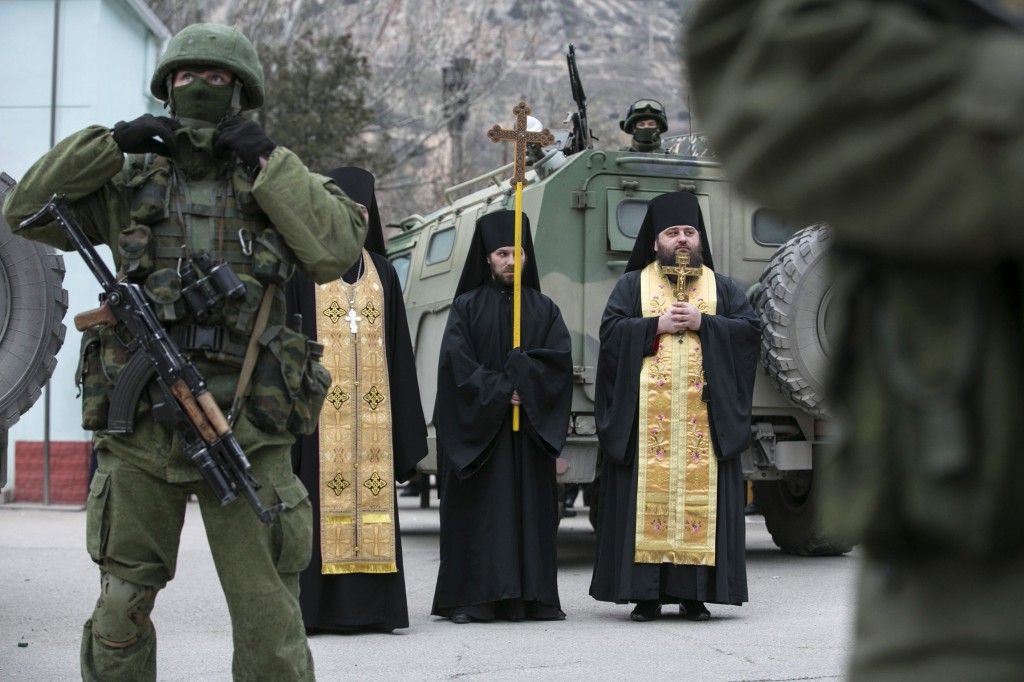

Russia’s aggression against Ukraine is an extremely dangerous situation that should be of concern to all Americans, said a prominent Ukrainian Catholic priest.
“We are seeing a replay of the lead-up to World War II going on now,” said Father Andriy Chirovsky, pastor of St. Michael Ukrainian Catholic Church in Tucson and founder of the Metropolitan Andrey Sheptytsky Institute of Eastern Christian Studies at St. Paul University in Ottawa, Ontario. “It’s very similar events to what happened before World War II, except that in World War II, it was Hitler doing it.”
Ukraine, a nation of 46 million people with its own language, culture and traditions, sits just west of Russia and east of Poland. To put it in perspective, Syria, another hot spot, has a population of 22 million.
Many members of the Byzantine Ukrainian Catholic Church, like Father Chirovsky, are children of World War II refugees who fled Ukraine in the face of Soviet repression, when the church was outlawed.
“If you claimed to be Ukrainian Catholic, you faced either imprisonment because you were a counterrevolutionary … or they would put you into a psychiatric hospital because you claimed to belong to a church that didn’t exist,” Father Chirovsky said.
So how did the Ukrainian Catholic Church outlast such savage persecution? Father Chirovsky, who travels between Tucson to care for his parishioners and Ottawa to attend to his students, provided background to The Catholic Sun.
When World War II ended, the Soviet Union, led by Josef Stalin, annexed Ukraine. Ukrainian Catholic bishops, priests, nuns and many laity were arrested, tortured, imprisoned and martyred. Still, the church endured.
“It was the grandmothers in many cases who passed on the faith,” Father Chirovsky said in a phone interview from Tucson. Parents would have their children secretly baptized but were busy working and did not practice the faith openly.
“The grandmothers, who were powerless in that society, felt, ‘What can they do to me? I am old and weak.’ So that gave them the courage to pass on the faith to their grandchildren, and that’s how the church survived in great measure,” Father Chirovsky said.
Ukraine also had underground seminaries. A clandestine priest might be in charge of the formation of eight seminarians who, in order to limit losses if any of them were discovered, did not know each other.
Since the Soviets had confiscated all church property, including books, the priest in charge of the seminarians’ formation had a notebook that he would allow each seminarian to copy.
Others were sent to study in Russian Orthodox seminaries, with the understanding that, when the time was right, they could come out and make their allegiance to Rome known.
After Blessed John Paul II met with Soviet President Mikhail Gorbachev Dec. 1, 1989, Gorbachev proclaimed that the Ukrainian Catholics were free to register their faith.
“Nobody knew at that point how many people would identify themselves as Ukrainian Catholic,” Father Chirovsky said. “Not the CIA, not the KGB, not the Vatican — nobody knew. We didn’t know ourselves.”
Some thought it would be in the tens of thousands. Others projected the hundreds of thousands. Father Chirovsky said 5 million people stepped forward. In that first year, 1,000 Russian Orthodox priests made known their allegiance to the Ukrainian Catholic Church.
Father Chirovsky feels deeply that connection to the persecuted church, having been ordained by a priest who spent 18 years in a Soviet concentration camp. He recalls Cardinal Josyf Slipyj asking him to turn on the lights one day — he could not bear the dark as it reminded him too much of his imprisonment in Siberia.
“Even worse than facing outright persecution is the demoralizing force of consumerism and materialism that has crept into our hearts in North America and Western Europe. I hate to say it, but it’s like people have it too good and have forgotten what life is about,” Father Chirovsky said.





